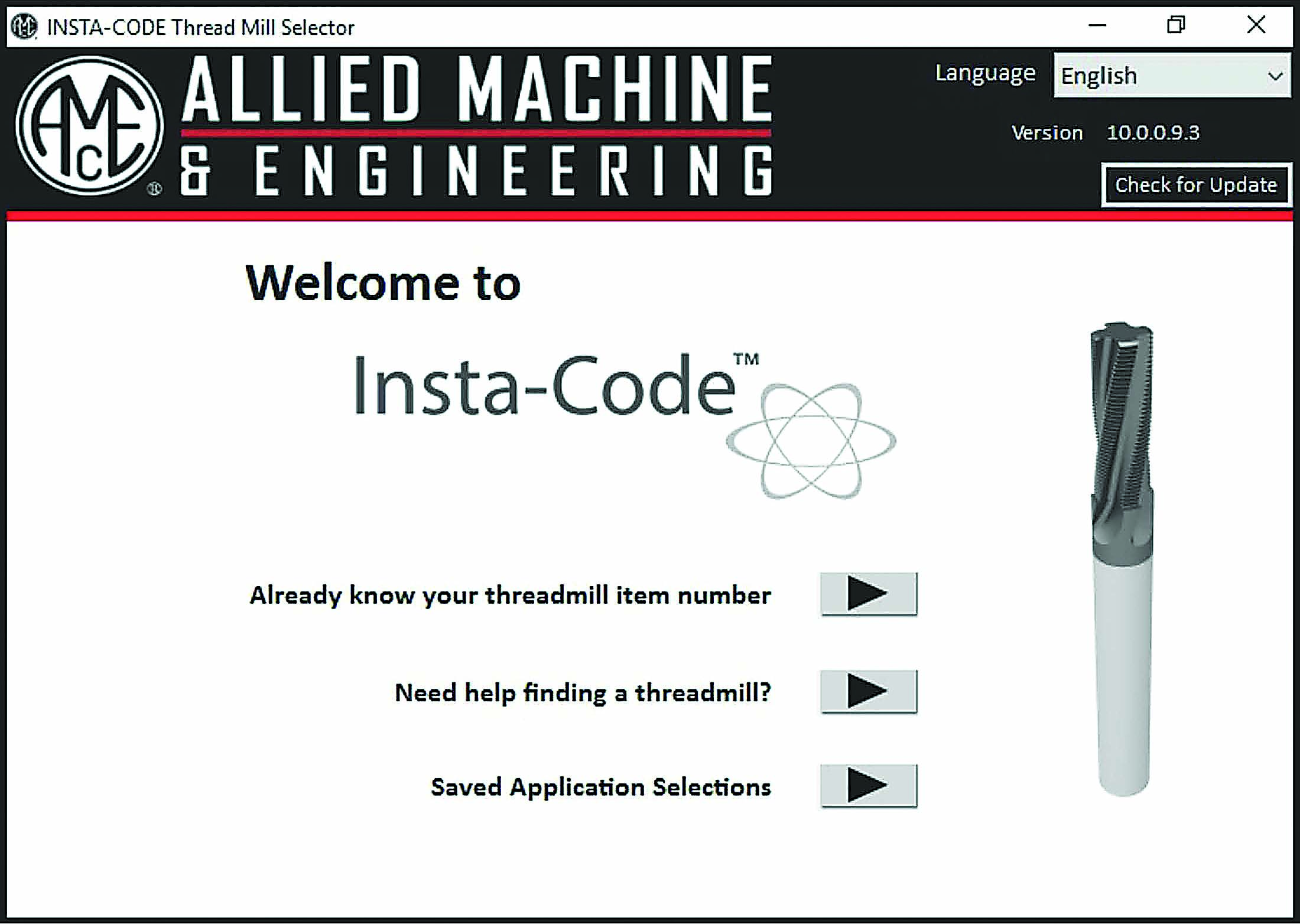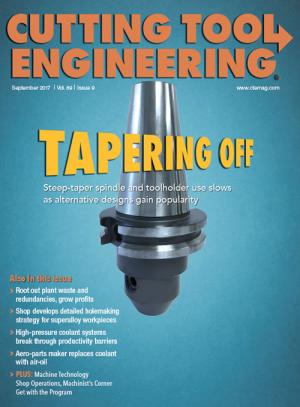Numerous toolmakers provide free programs that will automatically generate G code for a specific thread milling application. The programs vary in sophistication and in whether they are online-only or downloadable, but all are useful tools. Among the suppliers of these apps are Scientific Cutting Tools Inc., Simi Valley, Calif.; Guhring Inc., Brookfield, Wis.; and Kennametal Inc., Pittsburgh.
Allied Machine & Engineering Corp., Dover, Ohio, which recently released Insta-Code, is another. It gives users the ability to select the thread form, the thread pitch and information about the application and then creates the necessary program. If the thread mill item number is known, the software can create a program instantly. Insta-Code can also suggest the best thread mill for an application, as well as provide internal and external thread programs for multiple machine controller types, including Mazatrol, Siemens, Heidenhain, FANUC, as well as ISO G Code.

Allied Machine & Engineering’s Insta-Code program can suggest the best thread mill for an application. Image courtesy of Allied Machine & Engineering.
Jamie Rosenberger, Allied’s product manager for thread mills, helped develop Insta-Code. “After 15 years in the industry and trying numerous thread milling apps, I had the opportunity to include features I’d wished they had.”
For example, while some program generators are online-only, “I wanted to make sure that where you need to run a thread mill is where you can create the thread mill program,” Rosenberger said. “Online-only versions are easy to keep up-to-date, but often on the shop floor there’s no internet access.” For this reason, Insta-Code can be downloaded to a flash drive and installed on a machine’s offline computer.
OSG USA Inc., Irving, Texas, also has a downloadable version of a thread mill code-generating program, and, like Allied’s program, it’s available in numerous languages. ThreadPro is an NC-code generator for use with OSG’s Planet Cutter thread mills.
A customer’s need for such a program is easily understood, especially when working with hardened steel “or when you are making a part that costs, say, $10,000 and the last operation is threading a couple of holes,” said Balbir “Bill” Minhas, OSG senior application engineer. “You don’t want to scrap that part.”
Thread mill program-generating software is not new, according to Minhas. OSG has offered the service “as long as I can remember,” he said, adding that it predates his joining the company more than 5 years ago. ThreadPro, which was released about a year ago, replaces earlier software versions and has capabilities beyond generating G Code, including supplying the feeds and speeds appropriate to the material being cut.
ThreadPro is also much easier to use than its predecessor, Minhas said. “You just fill in the blanks” by plugging in the numbers regarding a specific application, “and it makes the program.”
Contact Details
Related Glossary Terms
- flash
flash
Thin web or film of metal on a casting that occurs at die partings and around air vents and movable cores. This excess metal is due to necessary working and operating clearances in a die. Flash also is the excess material squeezed out of the cavity as a compression mold closes or as pressure is applied to the cavity.
- gang cutting ( milling)
gang cutting ( milling)
Machining with several cutters mounted on a single arbor, generally for simultaneous cutting.
- milling
milling
Machining operation in which metal or other material is removed by applying power to a rotating cutter. In vertical milling, the cutting tool is mounted vertically on the spindle. In horizontal milling, the cutting tool is mounted horizontally, either directly on the spindle or on an arbor. Horizontal milling is further broken down into conventional milling, where the cutter rotates opposite the direction of feed, or “up” into the workpiece; and climb milling, where the cutter rotates in the direction of feed, or “down” into the workpiece. Milling operations include plane or surface milling, endmilling, facemilling, angle milling, form milling and profiling.
- milling machine ( mill)
milling machine ( mill)
Runs endmills and arbor-mounted milling cutters. Features include a head with a spindle that drives the cutters; a column, knee and table that provide motion in the three Cartesian axes; and a base that supports the components and houses the cutting-fluid pump and reservoir. The work is mounted on the table and fed into the rotating cutter or endmill to accomplish the milling steps; vertical milling machines also feed endmills into the work by means of a spindle-mounted quill. Models range from small manual machines to big bed-type and duplex mills. All take one of three basic forms: vertical, horizontal or convertible horizontal/vertical. Vertical machines may be knee-type (the table is mounted on a knee that can be elevated) or bed-type (the table is securely supported and only moves horizontally). In general, horizontal machines are bigger and more powerful, while vertical machines are lighter but more versatile and easier to set up and operate.
- pitch
pitch
1. On a saw blade, the number of teeth per inch. 2. In threading, the number of threads per inch.
- threading
threading
Process of both external (e.g., thread milling) and internal (e.g., tapping, thread milling) cutting, turning and rolling of threads into particular material. Standardized specifications are available to determine the desired results of the threading process. Numerous thread-series designations are written for specific applications. Threading often is performed on a lathe. Specifications such as thread height are critical in determining the strength of the threads. The material used is taken into consideration in determining the expected results of any particular application for that threaded piece. In external threading, a calculated depth is required as well as a particular angle to the cut. To perform internal threading, the exact diameter to bore the hole is critical before threading. The threads are distinguished from one another by the amount of tolerance and/or allowance that is specified. See turning.



